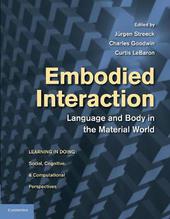
|
Embodied Interaction: Language and Body in the Material World
Paperback / softback
Main Details
| Title |
Embodied Interaction: Language and Body in the Material World
|
| Authors and Contributors |
Edited by Jurgen Streeck
|
|
Edited by Charles Goodwin
|
|
Edited by Curtis LeBaron
|
| Series | Learning in Doing: Social, Cognitive and Computational Perspectives |
|---|
| Physical Properties |
| Format:Paperback / softback | | Pages:326 | | Dimensions(mm): Height 279,Width 216 |
|
| Category/Genre | Sociolinguistics |
|---|
| ISBN/Barcode |
9781107630420
|
| Classifications | Dewey:302.2 |
|---|
| Audience | | Postgraduate, Research & Scholarly | |
|---|
| Illustrations |
3 Tables, unspecified; 82 Halftones, unspecified; 87 Line drawings, unspecified
|
|
Publishing Details |
| Publisher |
Cambridge University Press
|
| Imprint |
Cambridge University Press
|
| Publication Date |
2 January 2014 |
| Publication Country |
United Kingdom
|
Description
How do people organize their body movement and talk when they interact with one another in the material world? How do they coordinate linguistic structures with bodily resources (such as gaze and gesture) to bring about coherent and intelligible courses of action? How are physical settings, artifacts, technologies and non-linguistic sign-systems implicated in social interaction and shared cognition? This volume brings together advanced work by leading international scholars who share video-based research methods that integrate semiotic, linguistic, sociological, anthropological and cognitive science perspectives with detailed, microanalytic observations. Collectively they provide a coherent framework for analyzing the production of meaning and the organization of social interaction in the complex and heterogeneous settings that are characteristic of modern life. Embodied Interaction is indispensable for anyone interested in the study of language and social interaction. This volume will be a point of reference for future research on multimodality in human communication and action.
Author Biography
Jurgen Streeck is a Senior Fellow at Freiburg Institute for Advanced Studies (FRIAS) and associate professor of communication studies, anthropology, and Germanic studies at The University of Texas at Austin. He conducts micro-ethnographic, video-based research on language and bodily action in diverse cultural contexts and workplaces. Streeck has done fieldwork among African American children; in Germany, the Philippines, and Colombia; and in an auto shop in the United States. He is interested in the coordination of linguistic structure, gesture, and other communicative modalities; the phenomenology and philosophical anthropology of the body; the relationship between embodiment and emplacement; and the bodily foundations of cognition, language, and communication. His publications include Social Order in Child Communication, Children's World and Children's Language (with J. Cook-Gumperz and W. Corsaro), Gesturecraft: The Manu-Facture of Meaning, and New Adventures in Language and Interaction. Charles Goodwin is Professor of Applied Linguistics at UCLA. His interests include video analysis of talk-in-interaction; grammar in context; cognition in the lived social world; gesture, gaze, and embodiment as interactively organized social practices; aphasia in discourse; language in the professions; and the ethnography of science. Goodwin has done fieldwork analyzing family interaction in the United States, the work of oceanographers in the Amazon, archaeologists in the United States and Argentina, and the organization of talk, vision, and embodied action in the midst of surgery. As part of the Workplace Project at Xerox PARC, he investigated cognition and talk-in-interaction in ground operations at a major airport. As a member of the Sloan-funded Center for Everyday Lives of Families, he participated in an intensive cross-disciplinary project investigating the daily lives of middle-class, two-wage-earner families in Los Angeles. His publications include Conversational Organization: Interaction Between Speakers and Hearers, Rethinking Context: Language as an Interactive Phenomenon (edited with Alessandro Duranti), Conversation and Brain Damage, and Il Senso del Vedere: Pratiche Sociali della Significazione. Curtis LeBaron is an Associate Professor of Organizational Leadership and Strategy at Brigham Young University. He teaches graduate and executive education courses on leadership, human resources, and qualitative research methods. LeBaron conducts video-based research on behavior within organizational settings, focusing on topics such as interaction and identity, knowledge and innovation, and organizational strategy as practice. His research has been recognized by the National Institute of Health (Bethesda) and the National Communication Association (LSI division). Funding for research has come from a variety of sources, including the National Science Foundation, a Warren Jones Fellowship (Marriott School of Management), and an Erasmus Mundus Scholarship (EU). He has published in journals such as Journal of Communication, Research on Language and Social Interaction, Human Studies, Cognition and Instruction, and Computer Supported Collaborative Work. He is also the editor of Studies in Language and Social Interaction (with Phillip Glenn and Jenny Mandelbaum).
Reviews"Some of the best work now being done on the study of the intimate organization of human interaction is assembled in this book. It shows how, in interaction, multiple semiotic systems are always in play, and makes clear how no system studied in isolation, such as verbal expression or gesture, can be fully understood without grasping how it is orchestrated with others. The editors provide an extremely valuable introduction that sets the work presented in the volume in historical context and explains very clearly how the individual contributions fit together. The book will afford a major advance toward the inclusive theoretical framework that must eventually be developed if we are to have an appropriate grasp of how humans jointly achieve the coherent interactions through which they understand each other and the worlds in which they live. It will have very important implications for how language and human sociability are to be conceived of and understood." -Adam Kendon, Institute for Research in Cognitive Science, University of Pennsylvania "The papers gathered here make a powerful case for an integrated perspective on meaning making in embodied interaction in the material world - implying an important caveat for 'language first' or logocentric approaches to interaction." -Elizabeth Couper-Kuhlen, University of Helsinki
|